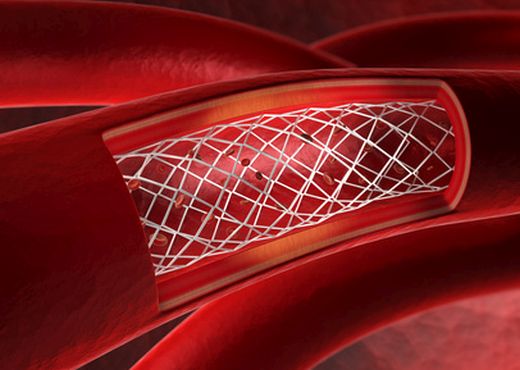Courtesy of Dr. Carlos Fava.
Currently, chronic total occlusions (CTO) are one of the obstacles that coronary angioplasties must overcome, particularly with the development of drug-eluting stents (DES) and new devices and strategies for these challenging lesions. However, there is little information on the safety, efficacy, and real clinical benefit of implanting stents of over 60 mm (known as full metal jackets, FMJ).
This study enrolled 406 consecutive patients with chronic occlusions localized in one of the major epicardial arteries. They received FMJ with DES (the type of DES, the strategy, and the devices used for rechanneling were left at the operator’s discretion).
The primary endpoint was target-lesion failure (TLF), defined as a composite of cardiac death, treated-vessel acute myocardial infarction, target-lesion revascularization, or re-occlusion during follow-up.
The mean age for this sample was 59.6 years old (most patients were male). Overall, 35% of all patients had diabetes and 70.2% presented dyslipidemia, 26.8% were smokers, 32.8% had undergone a prior angioplasty, and 3.9% had undergone previous myocardial revascularization surgery (MRS). Chronic stable angina was found in 80% of the population. The ejection fraction was 57%.
Also read: “Successful CTO Reduces Local and Remote Residual Ischemia.”
Multivessel lesions were found in 60.3% of all cases, left main coronary artery (LMCA) in 5.4%, and multiple CTOs in 9.4% of the patients. CTOs were more frequently located in the right coronary artery, followed by the anterior descending artery. The J-CTO score was 2.3 and there was blunt stump in 60% of all cases. Occlusions ≥20 mm: 40%.
The most used DES type was the second-generation DES (63%). In general, 2.5 ± 0.6 stent/patient were implanted: stent length was 76.8 ± 14.6 mm, and stent diameter was 3.2 ± 0.4 mm. IVUS was used in 90.6% of all cases, with a 503-mL contrast and a 60-minute fluoroscopy time. Peri-procedural acute myocardial infarction was found in 10 subjects (0.25%).
The follow-up was 5.1 years (2.4-7.1); the primary endpoint was present in 16% of all cases, the rate of overall mortality was 8.4%, and the rate of cardiac death was 5.7%. There were 17 patients who experienced re-occlusion and 5 cases of stent thrombosis (4 definitive ST and 1 probable ST).
In a multivariate analysis, the number of implanted stents (hazard ratio [HR]: 1.72, 95% confidence interval [CI]: 1.16 to 2.54; p = 0.006) and persistent distal luminal narrowing (HR: 2.73; 95% CI: 1.66 to 4.47; p < 0.001) were independent predictors of TLF.
Conclusion
CTO angioplasty with FMJ and DES provides acceptable long-term clinical results. Persistent distal luminal narrowing increases the future likelihood of adverse events despite procedural success.
Editorial Comment
This is a “real world” analysis with an acceptable long-term evolution, but we must take into account that the patients who presented CTO belonged to a group with more advanced coronary disease and a history of angioplasty and MRS, compared to patients without CTO. Surely, this must have impacted negatively on their long-term evolution.
The high rate of IVUS use, which probably contributed to better stenting, particularly in calcified or overlapping lesions, is an interesting piece of information.
In the future, the use of IVUS during FMJ implantation in CTO lesions will probably be mandatory (as it now is in cases of LMCA angioplasty).
Furthermore, we must take into account that these procedures are long and require high contrast. Finally, we must always overcome the learning curve.
Courtesy of Dr. Carlos Fava.
Original title: Full Metal Jacket with Drug-Eluting Stents for Coronary Chronic Total Occlusion.
Reference: Pil hyung Lee et al, J Am Coll Cardiol Interv 2017. Article in Press.
Subscribe to our weekly newsletter
Get the latest scientific articles on interventional cardiology
Sua opinião nos interessa. Pode deixar abaixo seu comentário, reflexão, pergunta ou o que desejar. Será mais que bem-vindo.






